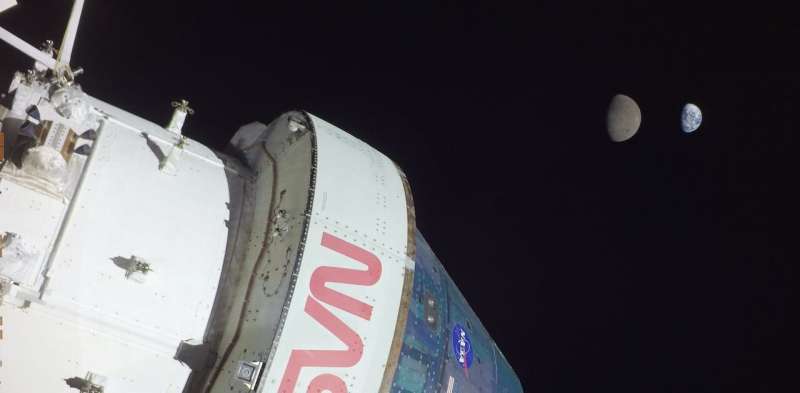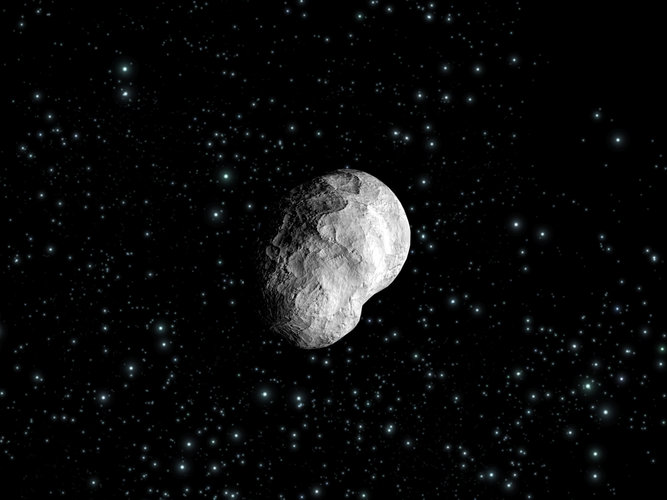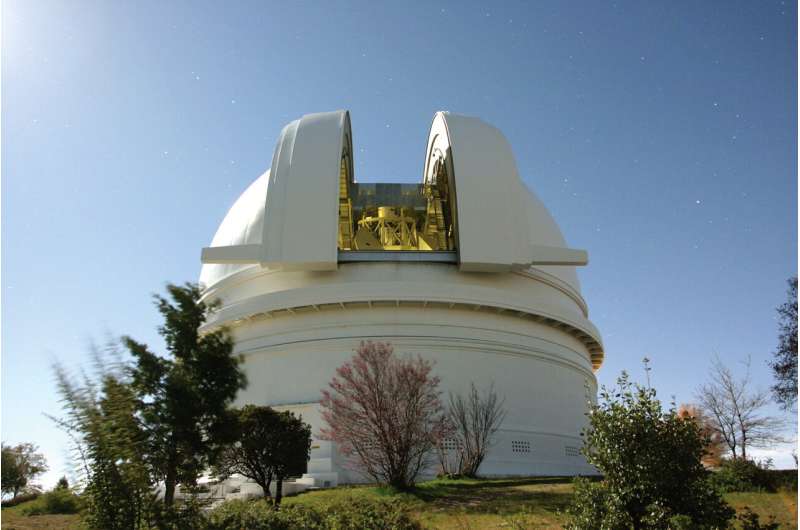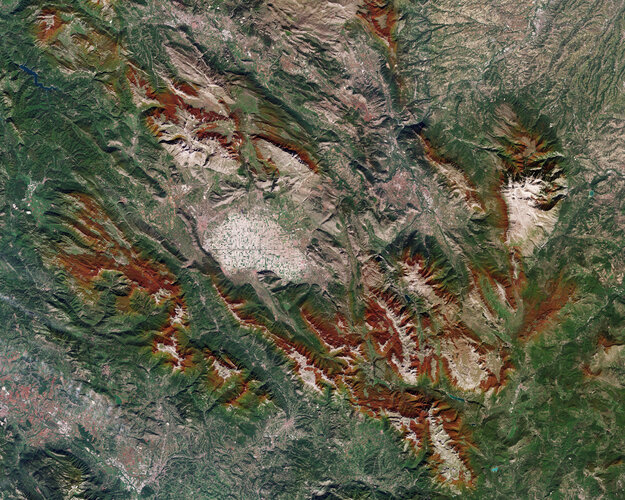
Copernical Team
Looking back from beyond the moon: How views from space have changed the way we see Earth

A photograph taken by NASA's Orion spacecraft has given us a new perspective on our home planet.
The snap was taken during the Artemis I mission, which sent an uncrewed vehicle on a journey around the Moon and back in preparation for astronauts' planned lunar return in 2025.
We get pictures of Earth every day from satellites and the International Space Station. But there's something different about seeing ourselves from the other side of the Moon.
How does this image compare to other iconic views of Earth from the outside?
Earthrise
In December 1968, three astronauts were orbiting the Moon to test systems in preparation for the Apollo 11 landing. When they saw Earth rise over the lunar horizon, they knew this was something special. The crew scrambled to find color film in time to capture it.
Photographer Galen Rowell called the resulting image "the most influential environmental photograph ever taken.
Christmas challenge: find mystery asteroid

Deep-space optical communication demonstration project forges ahead

Researchers report new results from the NASA Deep Space Optical Communications (DSOC) technology demonstration project, which develops and tests new advanced laser sources for deep-space optical communication. The ability to perform free-space optical communication throughout the solar system would go beyond the capabilities of the radio communication systems used now and provide the bandwidth necessary for future space missions to transmit large amounts of data, including high-definition images and video.
The demonstration system consists of a flight laser transceiver, a ground laser transmitter and a ground laser receiver. The downlink transmitter has been installed on the Psyche spacecraft, which will travel to a unique metal asteroid also called Psyche, which orbits the sun between Mars and Jupiter.
Malcolm. W. Wright, from the Jet Propulsion Laboratory, California Institute of Technology, will present the functional and environmental test results of the DSOC downlink flight laser transmitter assembly and ground uplink transmitter assembly at the Optica Laser Congress, 11-15 December 2022.
SpaceX gives rival's internet satellites ride to orbit

SpaceX launched internet satellites for a competitor Thursday, stepping in to help after the London-based OneWeb company halted its flights with Russia over the invasion of Ukraine.
The Falcon rocket blasted off at sunset with 40 mini satellites bound for polar orbit. They will expand OneWeb's constellation to just over 500, nearly 80% of the planned total of about 630 satellites.
Elon Musk's SpaceX has more than 3,200 Starlink satellites in orbit, providing high-speed, broadband internet to remote corners of the world.
Earth from Space: Fucino, Italy

Tucked away in the Fucino Valley, in central Italy, lies the Fucino Space Centre, where Telespazio will manage the early orbit activities of the Meteosat Third Generation Imager, set to launch on 13 December from Europe’s Spaceport in French Guiana.
Evaluating a Possible Drill Location
 The weekend drive went well and Curiosity is back on top of the marker band, investigating some intriguing rippled bedrock. We're assessing whether we want to drill at this location, based on what we see in the chemistry data.
So today's two-sol plan is devoted to collecting data from APXS and MAHLI (supplemented by ChemCam and Mastcam), to evaluate the bedrock in our workspace, as seen in
The weekend drive went well and Curiosity is back on top of the marker band, investigating some intriguing rippled bedrock. We're assessing whether we want to drill at this location, based on what we see in the chemistry data.
So today's two-sol plan is devoted to collecting data from APXS and MAHLI (supplemented by ChemCam and Mastcam), to evaluate the bedrock in our workspace, as seen in Phantoms return from beyond the Moon with valuable data on cosmic radiation doses
 Together with the Orion spacecraft of the Artemis I mission, as part of the MARE experiment, two human phantoms equipped with numerous cosmic rays detectors are to land on Earth. The information gathered by the detectors will for the first time verify the knowledge, crucial for the presence of humans in deep space, of the effects of cosmic rays on the health of the astronauts who are to live and
Together with the Orion spacecraft of the Artemis I mission, as part of the MARE experiment, two human phantoms equipped with numerous cosmic rays detectors are to land on Earth. The information gathered by the detectors will for the first time verify the knowledge, crucial for the presence of humans in deep space, of the effects of cosmic rays on the health of the astronauts who are to live and Colgate-Palmolive and NASA sign Space Act Agreement to boost off planet hygiene
 Colgate-Palmolive Company has signed an agreement with the National Aeronautics and Space Administration (NASA) to explore innovative solutions to advance oral health, personal care and skin health for both astronauts in space and people around the globe. Former astronaut Dr. Cady Coleman will work alongside Colgate as an advisor to help guide research design and offer insights into the realitie
Colgate-Palmolive Company has signed an agreement with the National Aeronautics and Space Administration (NASA) to explore innovative solutions to advance oral health, personal care and skin health for both astronauts in space and people around the globe. Former astronaut Dr. Cady Coleman will work alongside Colgate as an advisor to help guide research design and offer insights into the realitie NASA taps Collins Aerospace to develop new spacesuits for Space Station
 NASA has awarded a task order to Collins Aerospace to deliver a spacewalking system for potential use outside the International Space Station. This award - the second under NASA's Exploration EVA Services contract - is for design and development of a next-generation spacesuit and support systems. The task order has a base value of $97.2 million.
Collins Aerospace will complete a critical d
NASA has awarded a task order to Collins Aerospace to deliver a spacewalking system for potential use outside the International Space Station. This award - the second under NASA's Exploration EVA Services contract - is for design and development of a next-generation spacesuit and support systems. The task order has a base value of $97.2 million.
Collins Aerospace will complete a critical d Evolving time-tested technology to outmatch hypersonic weapons inside the atmosphere
 When it comes to defending against hypersonic weapons that move and maneuver at more than five times the speed of sound, you need layers of defense and multiple opportunities to take out the threat.
Seeking the first missile specifically designed to defeat hypersonic threats in their most vulnerable phase of flight, the glide phase, the MDA selected Raytheon Missiles and Defense, or RMD, a
When it comes to defending against hypersonic weapons that move and maneuver at more than five times the speed of sound, you need layers of defense and multiple opportunities to take out the threat.
Seeking the first missile specifically designed to defeat hypersonic threats in their most vulnerable phase of flight, the glide phase, the MDA selected Raytheon Missiles and Defense, or RMD, a 